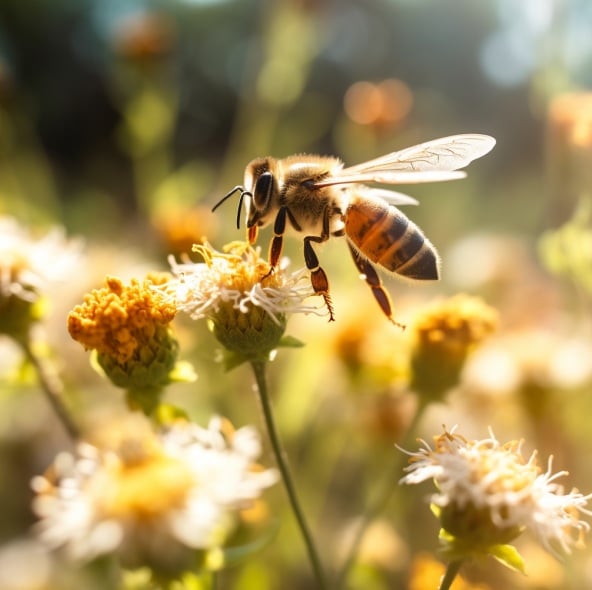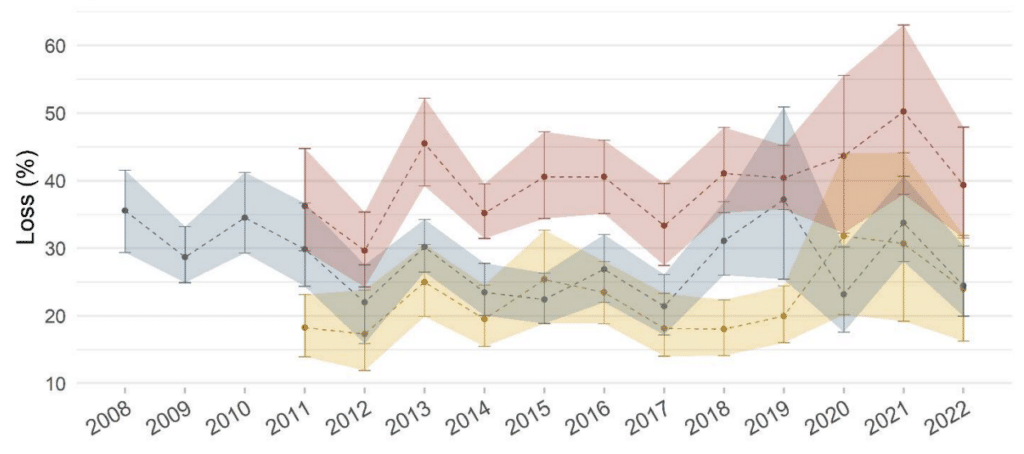Introduction – Endangered Bees?
Worries about bees are not unexpected because of a lot of attention put on news around “colony collapse disorder” which came into public attention in the 2010s. So what’s the update in 2023? Very briefly you should take away only 2 things from this article: first, colony losses remain elevated and continue to go up and down; second, even though there are colony losses, it doesn’t mean bees are endangered because beekeepers replenish the colonies.

Bees play a crucial role in the ecosystem and agriculture, as they help pollinate plants, contributing significantly to the world’s food production. Recent concerns about declining bee populations have raised alarm bells among scientists, environmentalists, and the general public.
This article delves into the conservation status of bees, their role in sustainable living, and the steps individuals can take to help protect them.
Elevated Colony Losses Are Continuing From 2010 To 2022
The Bee Informed Partnership’s latest report indicates an improvement in honey bee colony loss rates in the United States over the last year, spanning April 2021 to April 2022.
During the summer of 2021 (April – October), an estimated 23.8% of managed colonies were lost, which was 7.3 percentage points lower than the previous summer’s loss of 31.1%. This rate, however, is still 1.3 points higher than the average summer loss since 2010, which stands at 22.5%.

For the winter of 2021-2022 (October – April), an estimated 24.2% of managed colonies were lost. This is an improvement of 9.3 points compared to the previous winter’s loss rate of 33.5%. The winter loss was also 4.3 points lower than the average winter loss (28.5%) since the survey began.
When considering the entire year, from April 2021 to April 2022, beekeepers in the United States experienced an estimated 39.0% loss in their managed honey bee colonies. This was an 11.8-point decrease from the previous year’s loss of 50.8%, which was the highest annual loss on record. The loss is also slightly lower (0.7 points) than the average annual loss rate of 39.7% over the last 11 years.
It’s important to note that backyard beekeepers experienced a higher annual rate of loss (58.5%) compared to commercial beekeepers (36.6%). This marked the highest annual rate of loss on record for backyard beekeepers, which is 10.6 points more than their 11-year average.
In summary, while there has been improvement in loss rates, the data indicates that beekeepers continue to face significant pressure to offset losses by creating new colonies each year, reflecting ongoing challenges to bee health and colony survival.
Are Bees Endangered or Threatened?
Understanding the conservation status of bees requires a grasp of terms such as endangered, threatened, and vulnerable. Endangered species face an imminent risk of extinction, while threatened species are likely to become endangered if their numbers continue to decline. Vulnerable species, on the other hand, are those particularly susceptible to adverse factors, such as habitat loss, disease, or human actions.
The conservation status of different bee species varies. Some are classified as endangered or threatened, while others are under observation due to the decline in their populations. Habitat loss and climate change play significant roles in this decline, as they disrupt bee nesting and foraging behavior.
When most people think about bees, they’re often thinking about honey bees. Honey bees, specifically the European honey bee (Apis mellifera), are not currently considered endangered. These are the bees primarily managed by beekeepers and are vital for agricultural pollination.
While honey bees are not endangered, they are facing significant challenges. Colony Collapse Disorder (CCD), a phenomenon where most worker bees in a colony disappear, has been a concern. However, reports of CCD have significantly declined in recent years.
The loss rate of managed honey bee colonies, though, remains high. Beekeepers have managed to keep the total number of colonies relatively stable over the years by replacing lost colonies, but this is a significant effort and not sustainable in the long run.
Honey Bees and the Endangered Species List
The current status of honey bees is not endangered, but they have been experiencing sharp declines in some regions. Factors contributing to the decline in honey bee populations include pesticide exposure, habitat loss, pests, and diseases. Honey bees are essential in sustainable food systems, as they are responsible for pollinating a large portion of agricultural crops.
Other Endangered Bee Species
In addition to honey bees, other endangered bee species play crucial roles in pollination and ecosystem health. Their endangerment can often be attributed to the loss of habitat, increased pesticide exposure, and climate change impacts.
Preserving these bee species is critical for maintaining biodiversity and supporting sustainable agriculture.
Several bee species have been classified as endangered or critically endangered, primarily by the U.S. Fish and Wildlife Service (USFWS) or the International Union for Conservation of Nature (IUCN). Here are a few:
- Rusty Patched Bumble Bee (Bombus affinis): Once common in the eastern and midwestern United States, this species is now listed as endangered by the USFWS.
- Franklin’s Bumble Bee (Bombus franklini): This species is critically endangered and may even be extinct. Its range was limited to a small area straddling Oregon and California.
- Yellow-Banded Bumble Bee (Bombus terricola): This species has suffered a major decline across its range in the U.S. and Canada.
- Hawaiian Yellow-Faced Bees (Hylaeus spp.): Several species of yellow-faced bees native to Hawaii have been listed as endangered by the USFWS.
- The Miami Blue Butterfly (Cyclargus thomasi bethunebakeri), although not a bee, is an important pollinator that is also considered endangered.
Recent Changes to Bee Conservation Status
Updates on bees being added or removed from endangered species lists highlight the importance of monitoring their populations and taking appropriate conservation actions. Legal and policy implications of these updates can encourage responsible land management practices, pesticide controls, and habitat restoration. Community-led conservation efforts also have the potential to protect and restore local bee populations.
Current Bee Populations and Predictions for the Future
Bee population trends are influenced by various factors, including habitat loss, disease, and climate change. Predictions for bee populations in the coming years are a cause for concern, with some studies suggesting that certain species may be threatened by extinction.
The potential impact of bee extinction by 2050 on sustainable food and ecosystems is significant and highlights the need for proactive conservation efforts.
Addressing Bee Decline in Your Garden
Creating a bee-friendly garden can help address the decline in bee populations. Organic gardening practices, such as avoiding harmful pesticides and herbicides, benefit bees and other pollinators. Planting native plants that support local bee species and providing nesting and foraging habitats can contribute to promoting healthy bee populations.
Bee Conservation and Sustainable Living
Bee conservation is an integral aspect of sustainable living. Embracing a zero-waste or low-carbon lifestyle can help protect bees by promoting ethical consumption and waste management practices. Supporting local and organic agriculture safeguards bee habitats, while educating others and advocating for policies that support bees can create a lasting impact.
Conclusion
Understanding and addressing the decline in bee populations is crucial for the health of our planet. Both personal and collective actions are necessary to protect these essential creatures, and embracing sustainable lifestyles can lead to a more resilient and flourishing world. By conservating bees, we not only safeguard our food systems but also contribute to a more sustainable and eco-friendly future.
